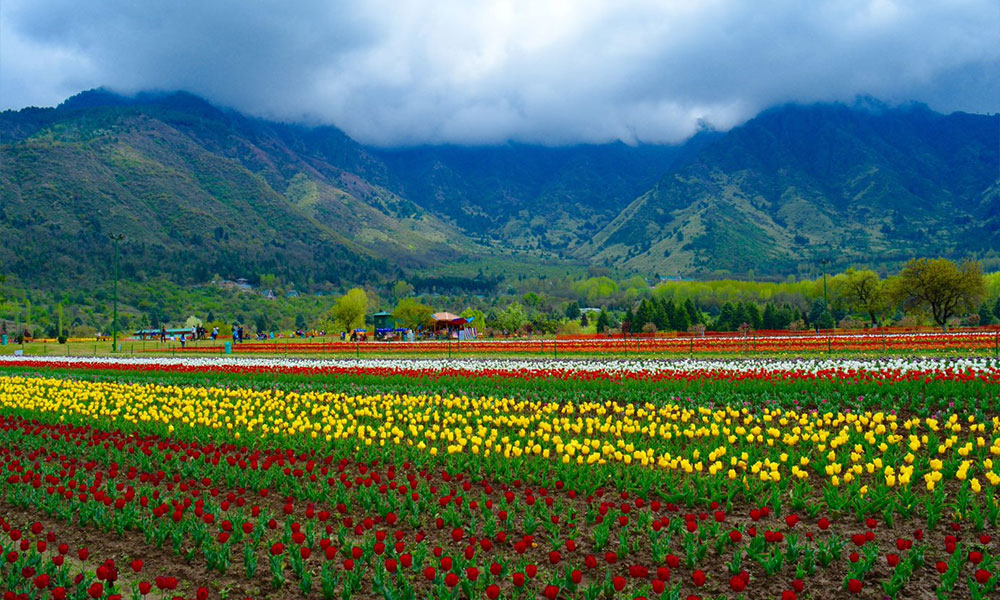Visit this paradise on earth. Luxuriate in a floating hotel otherwise called the houseboat in the beauteous environs of Dal lake. Romaticise as you float among the lotus on a moon night. Haggle at the floating fruit and flower markets at the crack of dawn. Among other customers are mallards and geese. Ski in the meadow of flowers and watch the sun rise from the golden meadow. The vale of Kashmir is heaven on earth.
As the legend goes, during the treta yuga, an evil power had taken control over the world. Mahalakshmi, Mahakali and Mahasaraswati combined their power to produce a powerful goddess, Vaishno Devi, to free the people of their suffering. After disposing of the evil power, she went to South India and meditated for Lord Rama. He appeared before Vaishnodevi who asked to be his wife. At that time Lord Rama was searching for his wife Sita who had been abducted by Ravana and refused, saying that he was already married. But if Vaishno Devi could recognise him when he returned next then he would marry her.
After killing Ravana and rescuing Sita, Rama returned to Vaishno Devi’s hermitage disguised as an old sadhu. Vaishno Devi did not recognise him. He consoled her saying that he would again be born in kalyug (the present age) and then they would get married. Lord Rama advised Vaishno Devi to stay in a cave in the Trikuta hills where Mahakali, Mahalakshmi and Mahasaraswati were staying. He also sent Hanuman to serve Her. Since that time Vaishno Devi has been there serving the world and waiting for Lord Rama’s return.
Emperor Jehangir’s love for Kashmir is legendary. Kashmiris never tire of telling you the Jehangir deathbed story. How as he breathed his last he whispered his dying wish, “Only Kashmir.” The Mughal emperor’s love for the Valley is reflected in his creation, Shalimar Gardens, romantic and florid but appropriately so since the garden is a labour of love for his beloved wife.
With all his passion for Kashmir, it was Jehangir’s grandson Dara Shikoh who grasped the essence of Kashmir’s sufi culture but remains the relatively unsung hero. He made several trips to Kashmir to commune with his teacher, Akhund Mulla Shah. Dara Shikoh built a magical garden high on a hill overlooking the Dal as a school for religious discourses. Fortunately for the spirit of the sufis, but not so for the devotees, the place has been closed for the public. Still, Kashmir is a virtual pilgrimage for sufi devotees. There is Akhund Mulla Shah’s shrine, built by Dara Shikoh for his teacher. It looks a little lonely next to the far more pop lar shrine of Makhdoom Sahib which gets all the visitors and most of the fanfare. During the annual urs, Makhdoom Sahib’s shrine is visited by thousands of people every day. En route to Lolab valley is the sufi shrine of Shah Walli, who was reputed to have the power of raising the dead. Hazratbal Shrine, situated on the bank of famous Dal Lake, is the most important Muslim shrine of Kashmir. It commands the reverence of the people beyond measure as the Prophet Mohammad’s Moi-e-Muqqadas (the sacred hair) is preserved in it.
For centuries this idyllic Himalayan valley has been abode of sufi saints and sages who gifted it with the hallmark serenity and quietude. Amid the mesmerising tranquility emerged the soothing melodies of the sufiana moosiqi or music. Beauty is synonymous with Kashmir. This is one verdict everyone agrees to, be it Jehangir who calls Kashmir a paradise on earth or Francois Bernier, a French physician who likens it to the Garden of Eden.
The Frenchman must have had the Dal Lake in mind. This incredibly beautiful lake is guarded by mountains and flanked by the gardens built by the Mughals. The Dal is undoubtedly the chief ornament in the Kashmir Valley. Huge chinars, willows and tall poplars fringe the shore. Apricot and cherry, almond and pear, quince, and apple trees decorate the gardens. It is unique in having hundreds of houseboats that afford an opportunity for tourists to reside on the lake. The lake traffic system is equally unique. Shikaras are smaller and ornate versions of the gondolas of Venice and criss-cross the waterways offering myriad products from Amul cheese to pashmina shawls. They offer a variety of entertainment onboard - traditional sufiana music, the latest Bollywood item number, or even the odd-Beatles number to cater to the foreign tourist.
Tourist Places of Jammu and Kashmir
Gulmarg is 51 km from Srinagar. It is an ideal winter sports destination plus boasts of the highest golf course in the world. Among the places to see are Ningle Nallah and Lienmarg, a grassy meadow offering excellent camping sites. On the banks of Ferozepur Nallah is a popular tourist spot called Waters Meet. The Outer Circular Walk encircles Gulmarg and provides scenic views of the massifs of Nanga Parbat, Harmukh, the rugged slopes of Ferozepur, Sunset Peak and Apharwat Ridge.
Khilanmarg is a 40-minute far away from Gulmarg through valleys of wildflowers to Khilanmarg, offering a breathtaking view of the majestic peaks with their reflection in Wular and other lakes.
Sonamarg is 95 km from Srinagar and is the last major town before Ladakh and an excellent base for trekking.
Vaishno Devi is located in Trikuta Mountain and is 62 km from Jammu. The pilgrimage route is Katra, Ban Ganga, Charan Paduka, Adhkunwari, Bhavan, Vaishno Devi. Tourists need a pass to enter the shrine and are available at Katra.
Patni Top is just 118 km from Amritsar while the nearest air and railhead is at Jammu.
